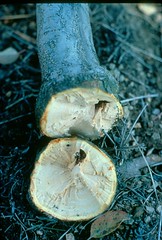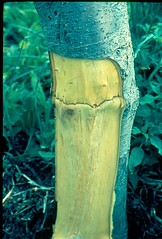Apple union necrosis and decline (AUND) is caused by tomato ringspot virus (TmRSV). TmRSV also causes disease in other fruit trees (Prunus stem pitting of peach and nectarine, brownline/constriction disease of Stanley prune) as well as in small fruits and many herbaceous plants. AUND is of economic importance in commercial apple orchards, where the virus most often is isolated from clonally propagated, size-controlling rootstocks. This disease is only a problem on grafted trees where the fruiting variety is resistant to TmRSV and the rootstock is tolerant. (Tolerant, in this case, means that the rootstock harbors the virus but does not suffer from it.) Apple cultivars vary in resistance or tolerance to TmRSV. Rootstocks tolerant to TmRSV include MM.106, M.7A, M.26, M.9, MAC39, MAC9, P2, and Bud. 9. Resistant rootstocks include M.4, M.7, Ottawa 3, and Novole. Fruiting varieties resistant to TmRSV include ‘Delicious’, ‘Quinte’, ‘Tydeman’s Red’, ‘Jerseymac’, and ‘Jonathan’. ‘Golden Delicious’, ‘Empire’, and ‘York Imperial’ are tolerant. Ornamental crab apples and other Malus species appear unaffected. Response of affected apple cultivars on seedling roots may be variable depending on seedling parentage.
Symptoms of AUND appear as infected trees reach bearing age. Bud break often is delayed in the spring, and leaves are small and sparse, their color a dull pale green. Terminal shoot growth is reduced, with shortened internodes. Infected trees flower heavily and set large numbers of small, highly colored fruit. Leaf discoloration and leaf drop occur prematurely in infected trees. Affected trees often produce large numbers of sprouts from the rootstock. Swelling may occur above the graft union. Partial to complete separation of the graft union is common on severely affected trees; sometimes the top breaks off at the union in strong winds (figs. 1, 2). Decline and death are possible, although the infection is not always lethal. Removal of the bark above and below the graft union reveals that the graft union is abnormally thick, spongy, and orange-colored and that a distinct necrotic line exists at the graft union. Symptom severity is influenced by scion/rootstock combination; ‘Delicious’ on MM.106 rootstock produces extreme symptoms when infected, whereas ‘Golden Delicious’, ‘Empire’, and ‘York’ seldom show symptoms even when the rootstock is infected with TmRSV.
The virus is present in common broadleaf orchard weeds, such as dandelion, and dagger nematodes may spread the virus from these weeds to apple trees. Also, the virus may be spread through grafting, and from orchard to orchard by seeds from infected dandelion.
To avoid introducing the virus into new plantings, purchase only certified virus-free trees from a reputable nursery. You cannot cure trees of AUND after you have established them in your orchard. Reduce populations of nematode vectors and weed hosts by cultivating future orchard sites for 2 years before planting. Also, avoid planting AUND-prone combinations, such as ‘Delicious’/MM.106, and maintain good broadleaf weed control in affected areas.
Resource
http://www.caf.wvu.edu/kearneysville/disease_descriptions/omaund.html
Adapted by Alan R. Biggs, West Virginia University.
The original version of this article appeared in The Mid-Atlantic Orchard Monitoring Guide (NRAES-75) and is reproduced with permission from the Natural Resource, Agriculture, and Engineering Service, Cooperative Extension, 152 Riley-Robb Hall, Ithaca, New York 14853-5701, U.S.A. (607) 255-7654.


